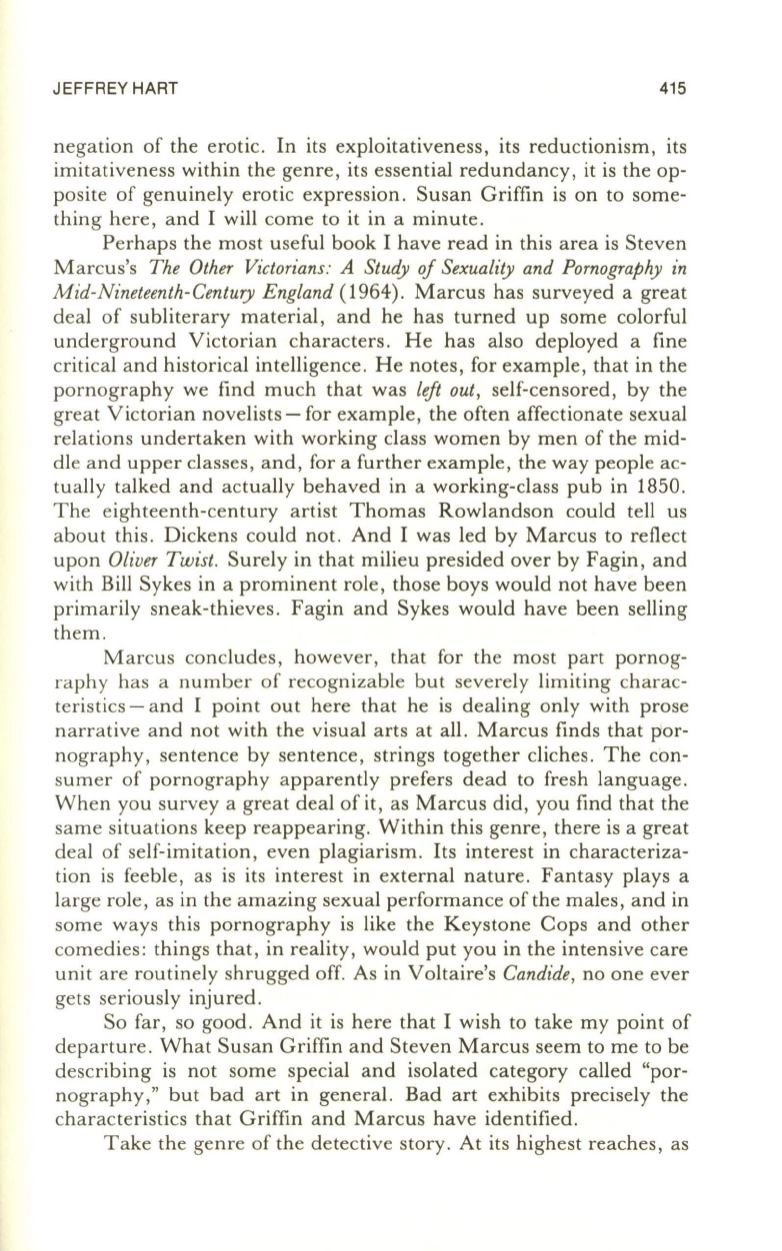
JEFFREY HART
415
negation of the erotic. In its exploitativeness, its reductionism, its
imitativeness within the genre , its essential redundancy, it is the op–
posite of genuinely erotic expression . Susan Griffin is on to some–
thing here, and I will come to it in a minute.
Perhaps the most useful book I have read in this area is Steven
Marcus's
The Other Victorians : A Study of Sexuality and Pornography in
Mid-Nineteenth-Century England
(1964). Marcus has surveyed a great
deal of subliterary material, and he has turned up some colorful
underground Victorian characters. He has also deployed a fine
critical and historical intelligence. He notes, for example, that in the
pornography we find much that was
left out,
self-censored, by the
great Victorian novelists - for example, the often affectionate sexual
relations undertaken with working class women by men of the mid–
dle and upper classes, and, for a further example, the way people ac–
tually talked and actually behaved in a working-class pub in 1850.
The eighteenth-century artist Thomas Rowlandson could tell us
about this. Dickens could not. And I was led by Marcus to reflect
upon
Oliver Twist.
Surely in that milieu presided over by Fagin, and
with Bill Sykes in a prominent role, those boys would not have been
primarily sneak-thieves. Fagin and Sykes would have been selling
them .
Marcus concludes, however, that for the most part pornog–
raphy has a number of recognizable but severely limiting charac–
teristics - and I point out here that he is dealing only with prose
narrative and not with the visual arts at all. Marcus finds that por–
nography, sentence by sentence, strings together cliches. The con–
sumer of pornography apparently prefers dead to fresh language.
When you survey a great deal of it, as Marcus did, you find that the
same situations keep reappearing. Within this genre, there is a great
deal of self-imitation, even plagiarism. Its interest in characteriza–
tion is feeble, as is its interest in external nature. Fantasy plays a
large role, as in the amazing sexual performance of the males, and in
some ways this pornography is like the Keystone Cops and other
comedies: things that, in reality, would put you in the intensive care
unit are routinely shrugged off. As in Voltaire's
Candide,
no one ever
gets seriously injured.
So far, so good. And it is here that I wish to take my point of
departure. What Susan Griffin and Steven Marcus seem to me to be
describing is not some special and isolated category called "por–
nography," but bad art in general. Bad art exhibits precisely the
characteristics that Griffin and Marcus have identified.
Take the genre of the detective story . At its highest reaches, as


